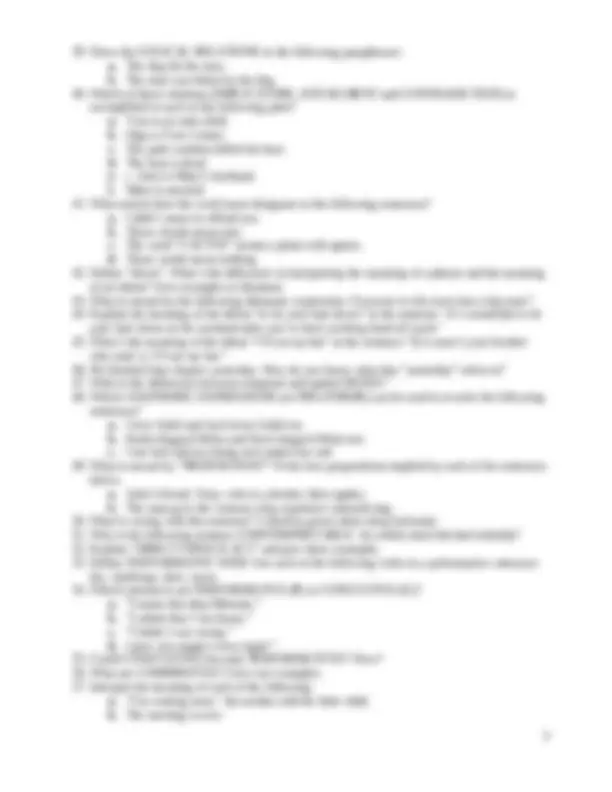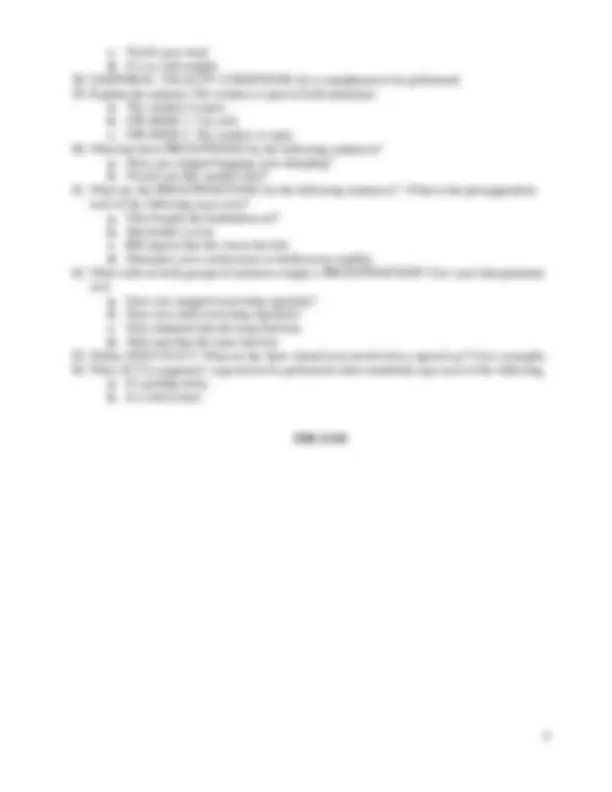English Semantics
Questions for review
1. What is meant by SEMANTIC FEATURES? Describe the semantic features of each of the
following words: house, home, class, school.
2. Provide the semantic features associated with each of these words: dog, puppy, cat, kitten.
3. Indicate the semantic features of the words stallion and girl.
4. State the semantic properties of the following words and then classify them into groups of
words which share the same semantic properties/features:
a. child, actress, doe, oak, make, plod, imagine, elm, build, charity, ewe, tiptoe, stalk
5. What are the semantic properties/features of the following words: die, kill, thicken, bachelor?
6. Give some examples to illustrate the same semantic property which can be shared by words of
different categories.
7. What is the semantic property shared by each of the following word groups?
a. mother, breast-feed, pregnant
b. darken, kill, beautify
8. Apply the MEANING POSTULATE for the sentence “If X gives Y to Z, then Z receives Y from
X,” and vice versa.
9. Justify that the following sentences contain phrases that have SENSE but no REFERENCE:
a. The present king of France is bald.
b. By the year 3000, our descendants will have left earth.
10. What are REFERENCE, REFERENT, & SENSE? Give examples for each.
11. Make a distinction between DENOTATION and CONNOTATION. Explain the meanings of the
adjectives in Russell’s example “I’m thrifty; you are tight; he is stingy,” and describe their
differences in connotation.
12. What is the meaning of the term CONNOTATION in semantics? What are the connotations
which the noun police may have?
13. Important factors for interpreting connotative meanings of words. Give examples to illustrate.
14. What are the CONNOTATIVE meanings which can be associated with the use of the words
child and winter?
15. Give the definitions of hyponymy, hypernym and hyponym.
16. Draw a chart to show the relationship between vocalize and croon.
17. What is the semantic relationship between the words in each pair of the following?
a. violin − fiddle
b. elbow − arm
c. big − small
18. What is Homonymy? What are two types of homonymy? Give example for each.
19. What is Homophony? Homography? Give examples.
20. What are the meanings which can be associated with the polysemous words break, delete, chip,
wing.
21. Give some examples to illustrate the difference in meaning between HOMONYMY and
POLYSEMY.
22. What are the related meanings of the word “mouth”? What is this type of interrelatedness
called?
23. The following words are POLYSEMOUS: chimney, guard. Give at least two possible closely
related meanings of each word and tell what common concept is contained in the meanings.
24. Which words in the following two sentences show the relation between them? Explain this
relation.
a. I gave Mary a rose.
1












